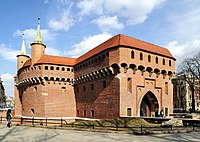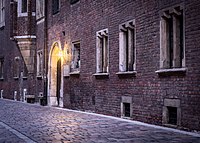
Back Arquitectura gótica en Polonia Spanish Poola gooti arhitektuur ET Architektura gotycka w Polsce Polish Gotska arhitektura na Poljskem SL
The Gothic architecture arrived in Poland in the first half of the 13th century with the arrival of the Dominican and Franciscan orders. The first elements of the new style are evident in the foundation of the Dominican Trinity church in Kraków (1226–1250),[1] built by Bishop Iwo Odrowąż. Rebuilding of the Wrocław Cathedral, started in 1244, was another early manifestation of the Gothic style. The earliest building in Poland built entirely in the Gothic style is the chapel of St. Hedwig in Trzebnica (1268–1269), on the grounds of a Cistercian monastery.
Gothic architecture was preceded by the Romanesque style, and some Romanesque buildings still survive, mostly in the north and west of the country (see here). Most Gothic buildings in Poland are made of brick, and belong to the Baltic Brick Gothic, especially in northern Poland (see Significant Brick Gothic buildings in Poland). Nonetheless, not all Gothic buildings in Poland are made of brick. Many buildings, e.g. the Wawel Cathedral in Kraków are mostly stone-built. Poland also has some Gothic fieldstone churches, mostly of relatively small size. The centres of Polish Gothic are Kraków, Gdańsk, Toruń and Wrocław.
The reign of king Casimir the Great was the time of the greatest flowering of gothic architecture in Poland. A similar development took place in the late Gothic phase, during the reign of Casimir the Jagiellonian.
In the region of Lesser Poland (in the south) buildings were built of brick with stone blocks used for some details. Churches built in the area are often two-nave, there are also some basilicas with relatively short aisles. Silesian Gothic resembles solution found in Lesser Poland, with some influence from Bohemia. As in Lesser Poland, Silesian Gothic buildings were mostly made of brick, with stone being used for details. One of the characteristics is the location of the tower – at the intersection of the transept of the church choir, on the south-east. The architecture of the northern Poland was strongly influenced by the Teutonic Order state buildings and Hansa cities. Churches in Pomerania were largely made of brick and were built as hall churches with tall towers, while basilicas were much less common. No new local form of the Gothic style developed in Mazovia, and Mazovian architecture dominated by simplified forms of Gothic styles found elsewhere.
- ^ Marek Strzala, Stroll through the historic Kazimierz area. Krakow Info.com (Internet Archive). Retrieved February 13, 2014.


